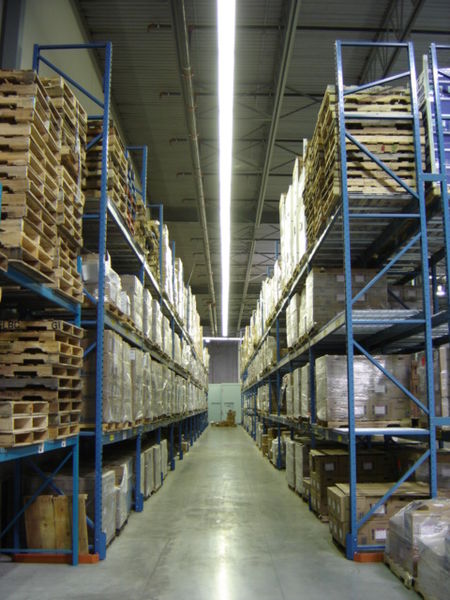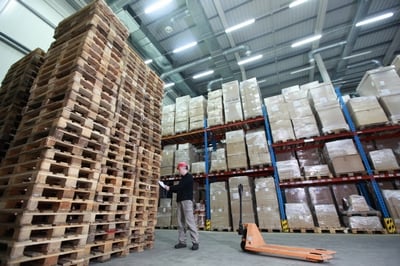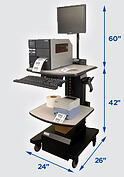 The order picking process has become an important part of the supply chain process. It is the most labor-intensive activity for almost every warehouse. The cost of order picking is estimated to be as much as 55% of the total warehouse operating expense. Considering the time and expense invested, even small improvements in the order picking process has an immediate impact on the bottom line.
The order picking process has become an important part of the supply chain process. It is the most labor-intensive activity for almost every warehouse. The cost of order picking is estimated to be as much as 55% of the total warehouse operating expense. Considering the time and expense invested, even small improvements in the order picking process has an immediate impact on the bottom line.
Since the order picking process involves significant cost and can have such an impact on customer satisfaction levels, there has been an increasing number of process improvements proposed to help companies with this supply chain issue. This is where Newcastle Systems saves the day. We help companies improve the process by integrating mobile carts with power to eliminate wasted steps.
Order picking can be defined as:
The activity by which a small number of goods are extracted from a warehousing system, to satisfy a number of independent customer orders.
Since picking labor typically accounts for on the order of half of all labor in the distribution center, it makes sense to consider better warehouse picking methods to optimize picking and speed up these processes. Even more so when you combine the other costs of picking, such as errors, stock-outs, damage, etc.
Order picking is the process of pulling items from inventory to fill a customer order. This takes place in a warehouse, and a company may use a variety of means to meet order picking needs. Employees who supervise this process do not need any special qualifications or training, as it is usually very straightforward. In some cases, it is entirely automated through the use of warehouse robots, and employees may not set foot on the warehouse floor unless there is a problem.
One order picking method requires sending an employee around the warehouse with an order list and a box or container. The picker pulls each item, following the most efficient route. In other warehouses, each worker is in charge of a section and pulls from her section to fill incoming orders. The box may move through several sections until the order is complete, often along a conveyor belt. Inventory robots can also perform picking tasks.
In piece picking, workers select items from open boxes or crates to fill small customer orders. A company selling books, for example, orders them by the case to stock the warehouse, but very few customers order a whole case of books at once. The company needs to open the cases to fill orders. Case or crate picking involves pulling full cases from inventory to fill orders, a common situation for wholesale warehouses sending goods to retailers. Companies can also use pallet picking, where whole pallets are pulled during the picking process for very large orders.
The order picking process includes a number of stages, from receiving the order to verifying the contents before closing the package and sending it out. Many companies rely on computer systems to streamline the process and also design their warehouses for maximum efficiency. Moving products that tend to be ordered together to the same area of the warehouse, for example, can cut down on the time needed to fill orders. This will allow the company to fill more orders, and to fill orders in a very timely fashion. Fast turnaround is expected by many customers.
Warehouse systems require periodic updates, and when a company gets ready to make changes to its warehouse, it may call on a consultant for advice. The consultant can evaluate standards and practices in the company and provide information on how to make order picking faster and more reliable. This may include adopting a new computer system, relying on more robots, or changing shelving layouts to make it easier for employees to pull what they need.
We can identify the following main types of order picking:
- Piece picking or picker to part method: the order picker(s) move(s) to collect the products necessary for one order
- Zone picking method: each order picker is assigned to one specific zone and will only realize order picking within this zone
- Wave picking method: the order picker(s) move(s) to collect the products necessary for several orders
- Sorting systems method: no movement of the order picker(s), the products are brought to him by an automatic system (conveyor system, automatic storage ...).
- Pick to box method: no movement of the order picker(s), the picking area is organized so that there are a number of picking stations connected by a conveyor. The order picker fills the box with the products from his station and the box moves to the other picking stations until the customer order is complete.
Solutions For Order Picking
A number of supply chain academics such as G.P. Sharp and Edward Frazelle have proposed a number of ways of classifying the order picking system. Four solutions have been identified for order picking.
- Picker to Part
- Part to Picker
- Sorting System
- Pick to Box
There are various ways in which a pick may be communicated to a picker:
- A simple paper pick list
- RF terminal
- A list of labels that list an item's location -one per item being picked
- Voice picking equipment
- Pick to light equipment
- Automated storage and retrieval systems (ASRS). There are many types, but the basics are mini-load, mid-load and unit load. Each system is used to deliver totes, cases, cartons, pallets or inventory with unique physical profiles. Mini-Loads usually range up to 1000 lbs per load; Mid-Load up to 2000 lbs per load; Unit Load for pallets up to 5000 lbs per pound.
- An automated dispenser, in which products are piled up and separated from each other, and then automatically released on a conveyor belt when required (obviously not applicable to all types of merchandise)
Some of these technologies can also be used to make sure the picker picked from the proper location using barcode or RFID terminal or voice picking.
Choosing an order picking system depends on any number of requirements such as cost, complexity, number of customer orders, size and number of items, etc. Every company has a unique requirement and one order picking solution may suit one business and not another. Determining the requirements will ensure that the most efficient order picking solution is selected.
 WAREHOUSE PICKING METHODS
WAREHOUSE PICKING METHODS
Paper Picking: Paper Picking is an easy warehouse picking method using printed sheets from your WMS or ERP.
RF Picking: Picking using mobile computers is a very easy step up from paper. All warehouse movements are logged and tracked, resulting in better inventory accuracy and providing total accountability to your labor budget as well as what individual are doing all day long.
Voice Directed Picking: In the past decade these warehouse picking methods have grown tremendously in order picking. The hardware cost is higher than for a mobile handheld device. However unlike pick-to-light, the cost scales with the number of users, not the number of SKUs making it overall very cost effective in certain situations.
Zone Pick to Light: The acknowledged speed and accuracy leader in the warehouse, pick to light warehouse picking methods can typically allow operators to reach 300-400 lines picked per person-hour in concentrated zones, when combined with routing systems and/or cluster or batch picking techniques.
Pick to Put - Pick to Put: Also known as Pack to Light, is a special adaptation of Pick to Light or hybrid Pick to Voice system that leverages the ability to batch pick lines and distribute them among orders placed in a cart, or a sled on a conveyor. Pick to Put systems can allow operators to reach 600 to 800 lines per person-hour, and for cart based systems minimize the need for conveyor systems. Like those systems they can be easily moved to another facility as the company grows. “Put” techniques are especially useful when a small number of SKUs has to be distributed among a large number of orders, for example in retail distribution to a large number of small stores.
 How to improve order picking without adding software:
How to improve order picking without adding software:
With so many distribution centers, retailers and manufacturers operating in what might be considered the "stone age" of technology and systems, giving up the stand up work station and replacing it with a mobile cart with a battery pack may seem a bit foreign.
Imagine what happens when a cart with a battery pack follows the Order Picker and the wasted steps are eliminated. Accuracy improves, better productivity is instant and the staff morale is higher as they get more done, in less time with less work.
To make your order picking staff happy, improve accuracy and brag about better productivity, you can configure your own workstation or get quote:
photo courtesy of Wikipedia.org











